2015 AUDI S3 SEDAN roof
[x] Cancel search: roofPage 139 of 282
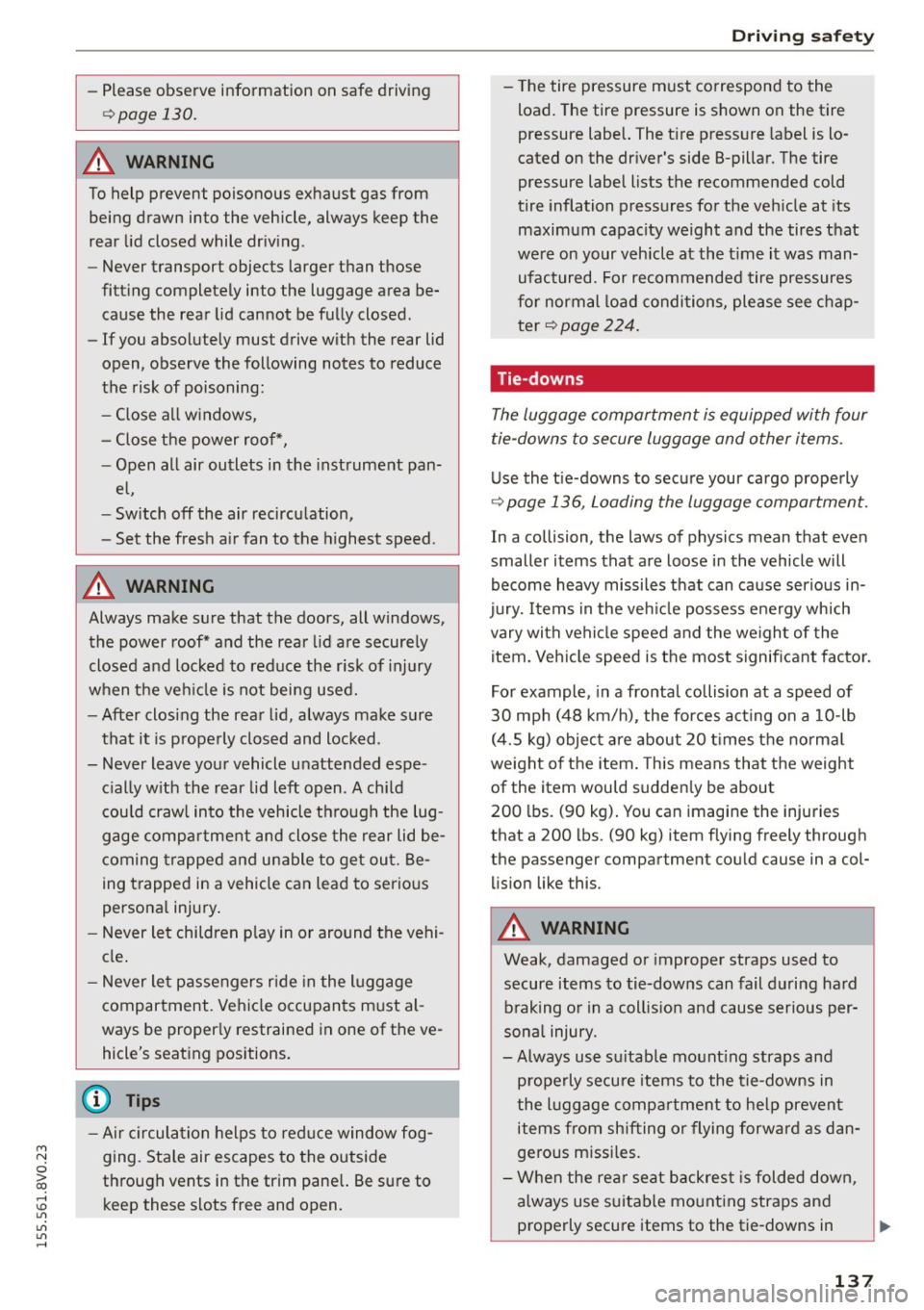
M N
0 > co ..... \!) 1.1"1
1.1"1
1.1"1
.....
-Please observe information on safe driving
~page 130.
A WARNING
To help prevent poisonous exhaust gas from
being drawn into the vehicle, always keep the
rear lid closed while driving .
- Never transport objects larger than those
fitting completely into the luggage area be
cause the rear lid cannot be fully closed.
- If you absolutely must drive with the rear lid
open, observe the following notes to reduce
the risk of poisoning:
- Close all windows,
- Close the power roof*,
- Open all air outlets in the instrument pan-
el,
- Switch off the air recirculation,
- Set the fresh air fan to the highest speed.
A WARNING
Always make sure that the doors, all windows,
the power roof* and the rear lid are securely
closed and locked to reduce the risk of injury
when the vehicle is not being used.
-After closing the rear lid, always make sure
that it is properly closed and locked.
- Never leave your vehicle unattended espe
cially with the rear lid left open . A child
could crawl into the vehicle through the lug
gage compartment and close the rear lid be
coming trapped and unable to get out. Be
ing trapped in a vehicle can lead to serious
personal injury.
- Never let children play in or around the vehi
cle.
- Never let passengers ride in the luggage
compartment. Vehicle occupants must al
ways be properly restrained in one of the ve hicle's seating positions.
(D Tips
- Air circulation helps to reduce window fog
ging. Stale air escapes to the outside
through vents in the trim panel. Be sure to keep these slots free and open.
Driving safety
-The tire pressure must correspond to the
load. The tire pressure is shown on the tire
pressure label. The tire pressure label is lo
cated on the driver's side B-pillar. The tire
pressure label lists the recommended cold
tire inflation pressures for the vehicle at its
maximum capacity weight and the tires that
were on your vehicle at the time it was man ufactured. For recommended tire pressures
for normal load conditions, please see chap
ter ~
page 224.
' Tie-downs
The luggage compartment is equipped with four
tie-downs to secure luggage and other items.
Use the tie-downs to secure your cargo properly
~page 136, Loading the luggage compartment.
In a collision, the laws of physics mean that even
smaller items that are loose in the vehicle will
become heavy missiles that can cause serious in
jury. Items in the vehicle possess energy which
vary with vehicle speed and the weight of the
item. Vehicle speed is the most significant factor.
For example, in a frontal collision at a speed of
30 mph (48 km/h) , the forces acting on a 10-lb
(4.5 kg) object are about 20 times the normal
weight of the item. This means that the weight
of the item would suddenly be about
200 lbs. (90 kg). You can imagine the injuries
that a 200 lbs. (90 kg) item flying freely through
the passenger compartment could cause in a col
lision like this.
A WARNING
-Weak, damaged or improper straps used to
secure items to tie-downs can fail during hard
braking or in a collision and cause serious per
sonal injury .
- Always use suitable mounting straps and
properly secure items to the tie-downs in
the luggage compartment to help prevent
items from shifting or flying forward as dan
gerous missiles.
- When the rear seat backrest is folded down,
always use suitable mounting straps and
properly secure items to the tie-downs in
137
Page 153 of 282
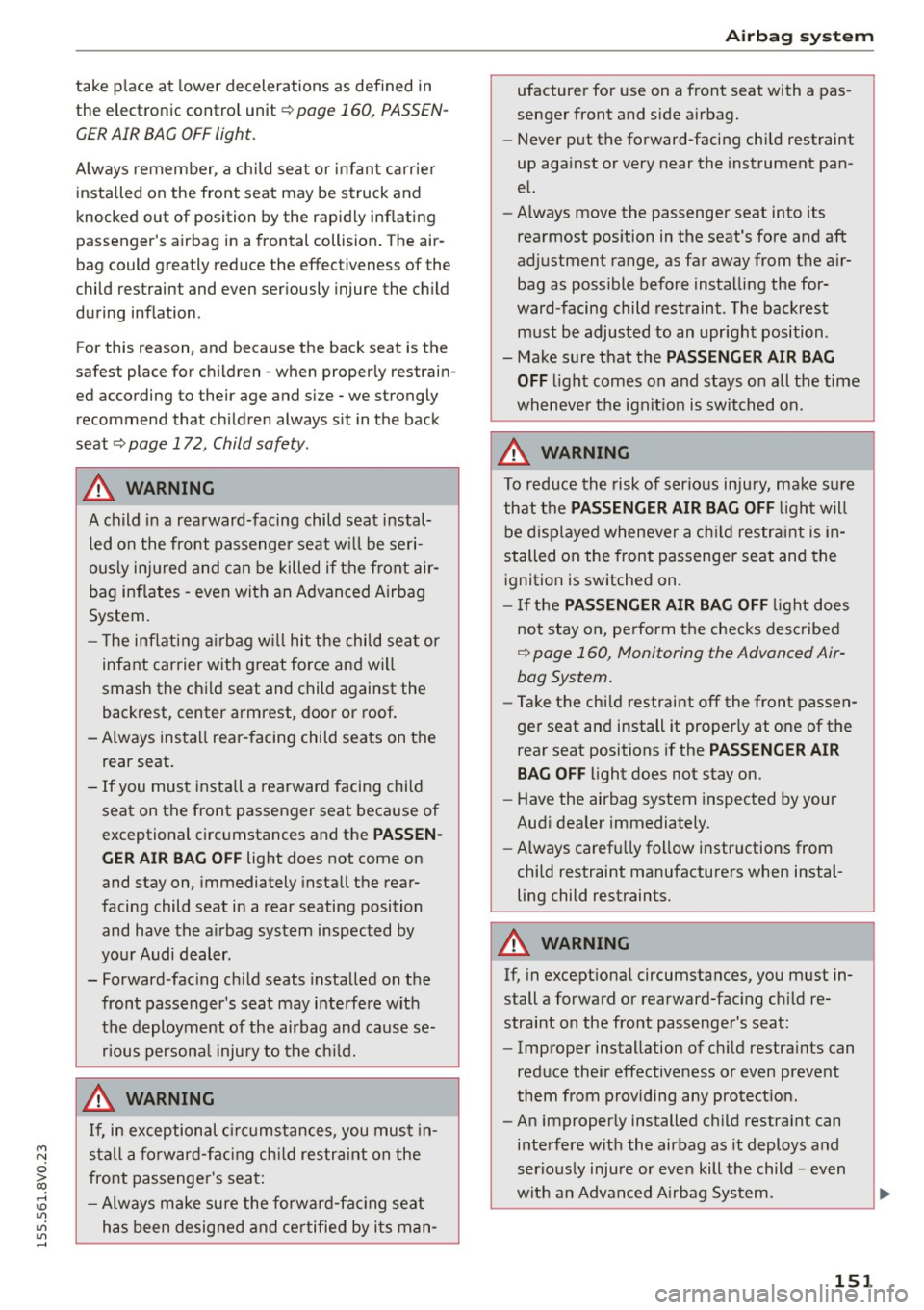
M N
0 > co ,...., \!) 1.1'1
1.1'1
1.1'1
,....,
take place at lowe r decelerations as defined in
the electronic contro l unit ¢
page 160, PASSEN
GER AIR BAG OFF light.
Always remember, a chi ld seat or infant carrie r
installed on the front seat may be struck and
knocked out of position by the rapidly inflating
passenger's a irbag in a frontal collision . The air
bag could greatly reduce the effectiveness of the
child restraint and even ser iously injure the ch ild
during inflation .
For this reason, and because the back seat is the
safest place for ch ildren -when properly restrain
ed according to their age and s ize -we strongly
recommend that ch ild ren always s it in the back
seat
¢ page 172, Child safety .
A WARNING
A child in a rearward-facing child seat instal
led on the front passenger seat w ill be seri
ously in jured and can be killed if the front air
bag inflates -even with an Advanced Airbag
System.
- T he inflating a irbag w ill hit the child seat or
infant carrier w ith great force and will
smash the child seat and child against the
backrest, center armrest, door or roof.
-
- Always install rear -facing child seats on the
rear seat.
- If you mus t install a rearward facing child
seat on the front passenger seat beca use of
exceptional circ umstances and the
PASSEN ·
GER AIR BAG OFF
light does not come on
and stay on, immediately install the rear
facing child seat in a rear seating position
and have the a irbag system inspected by
yo ur Audi dealer.
- Forward-fac ing ch ild seats installed on the
front passenger's seat may interfere with
the deployment of the airbag and cause se rious persona l injury to t he ch ild.
A WARNING
If, in exceptional c ircumstances, you mus t in
stall a forward-facing ch ild restraint on the
front passenger's seat :
- Always make sure the forward-fac ing seat
h as been designed and ce rtified by i ts man-
Airbag syste m
ufacturer for use on a front seat with a pas
senger front and s ide a irbag.
- Never put t he fo rward-facing child restraint
up aga inst or very near the instrument pan
el.
- Always move the passenge r seat into its
rearmost pos ition in the seat's fore and aft
ad justment range, as far away from the a ir
bag as possible before installing the for
ward-facing child restraint. The backrest
m ust be adjusted to an upr ight position .
- Make sure that the
PASSENGER AIR BAG
OFF
li ght comes on and stays on all the time
wheneve r the ignit ion is switched on.
A WARNING
= -To reduce the risk of serious inju ry, ma ke su re
that t he
PASSENGER AIR BAG OFF ligh t will
b e d isplayed whenever a ch ild restr aint is in
stalled on the front passenger seat and the
ignition is switched on.
- If the PASSENGER AIR BAG OFF light does
not stay on, pe rform the checks describe d
~ page 160, Monitoring the Advanced Air ·
bag System.
-Take the chi ld restraint off the front passen
ge r seat and install it properly at one of the
rea r seat positions if the
PASSENGER AIR
BAG OFF
light does not stay on.
- Have the airbag system inspected by your
Aud i dealer immediately.
- Always carefu lly follow instr uctions from
child restraint manufacturers when instal
ling child restraints.
A WARNING
If, in except ional circumstances, you m ust in
stall a forward or rearward-fac ing ch ild re
straint on the front passenger's seat:
- Improper installation of ch ild restra ints can
red uce their effectiveness or even prevent
them from providing any pro tect ion.
- An improperly installed ch ild restra int can
interfere with the airbag as it deploys and
serio usly injure or even kill the child -even
with an Advanced A irbag Sys tem.
~
151
Page 161 of 282
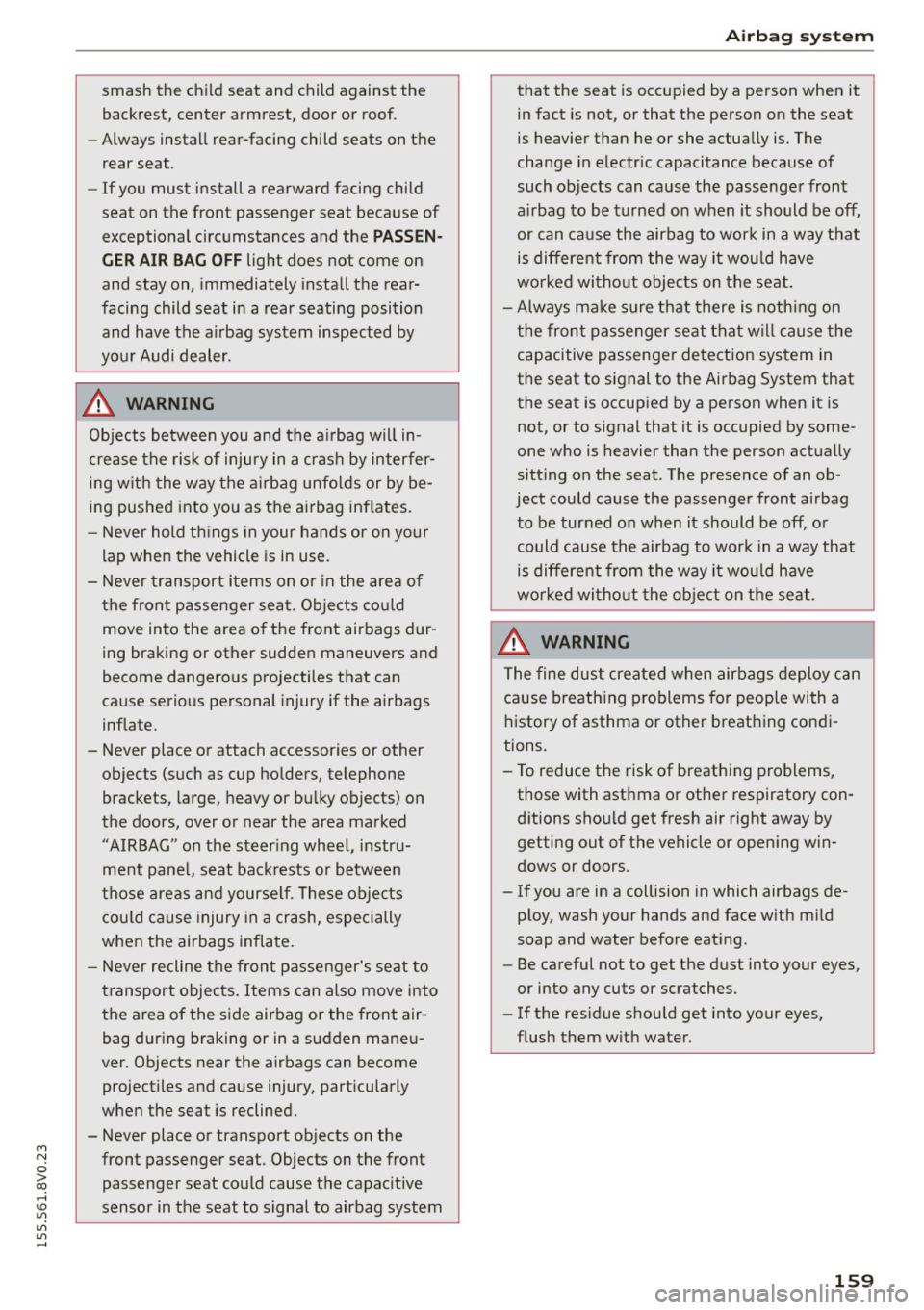
M N
0 > co ,...., \!) 1.1'1
1.1'1
1.1'1
,....,
smash the child seat and child against the
backrest, center armrest, door or roof.
- Always install rear-facing child seats on the
rear seat.
- If you must install a rearward facing child
seat on the front passenger seat because of
exceptional circumstances and the
PASSEN
GER AIR BAG OFF
light does not come on
and stay on, immediately install the rear
facing child seat in a rear seating position
and have the airbag system inspected by
your Audi dealer.
A WARNING
Objects between you and the airbag will in
crease the risk of injury in a crash by interfer
ing with the way the airbag unfolds or by be
ing pushed into you as the airbag inflates.
- Never hold things in your hands or on your
lap when the vehicle is in use.
- Never transport items on or in the area of
the front passenger seat. Objects could
move into the area of the front airbags dur
ing braking or other sudden maneuvers and
become dangerous projectiles that can
cause serious personal injury if the airbags
inflate.
- Never place or attach accessories or other objects (such as cup holders, telephone
brackets, large, heavy or bulky objects) on
the doors, over or near the area marked "AIRBAG" on the steering wheel, instru
ment panel, seat backrests or between
those areas and yourself. These objects could cause injury in a crash, especially
when the airbags inflate.
- Never recline the front passenger's seat to
transport objects. Items can also move into
the area of the side airbag or the front air
bag during braking or in a sudden maneu
ver. Objects near the airbags can become
projectiles and cause injury, particularly
when the seat is reclined.
- Never place or transport objects on the front passenger seat. Objects on the front passenger seat could cause the capacitive
sensor in the seat to signal to airbag system
Airbag system
that the seat is occupied by a person when it
in fact is not, or that the person on the seat
is heavier than he or she actually is. The
change in electric capacitance because of
such objects can cause the passenger front
airbag to be turned on when it should be off,
or can cause the airbag to work in a way that
is different from the way it would have
worked without objects on the seat.
-Always make sure that there is nothing on
the front passenger seat that will cause the
capacitive passenger detection system in
the seat to signal to the Airbag System that
the seat is occupied by a person when it is
not, or to signal that it is occupied by some
one who is heavier than the person actually
sitting on the seat. The presence of an ob
ject could cause the passenger front airbag to be turned on when it should be off, or
could cause the airbag to work in a way that is different from the way it would have
worked without the object on the seat.
_LD. WARNING
The fine dust created when airbags deploy can
cause breathing problems for people with a
history of asthma or other breathing condi
tions.
- To reduce the risk of breathing problems,
those with asthma or other respiratory con
ditions should get fresh air right away by
getting out of the vehicle or opening win
dows or doors.
- If you are in a collision in which airbags de
ploy, wash your hands and face with mild
soap and water before eating .
- Be careful not to get the dust into your eyes,
or into any cuts or scratches.
- If the residue should get into your eyes,
flush them with water.
159
Page 171 of 282
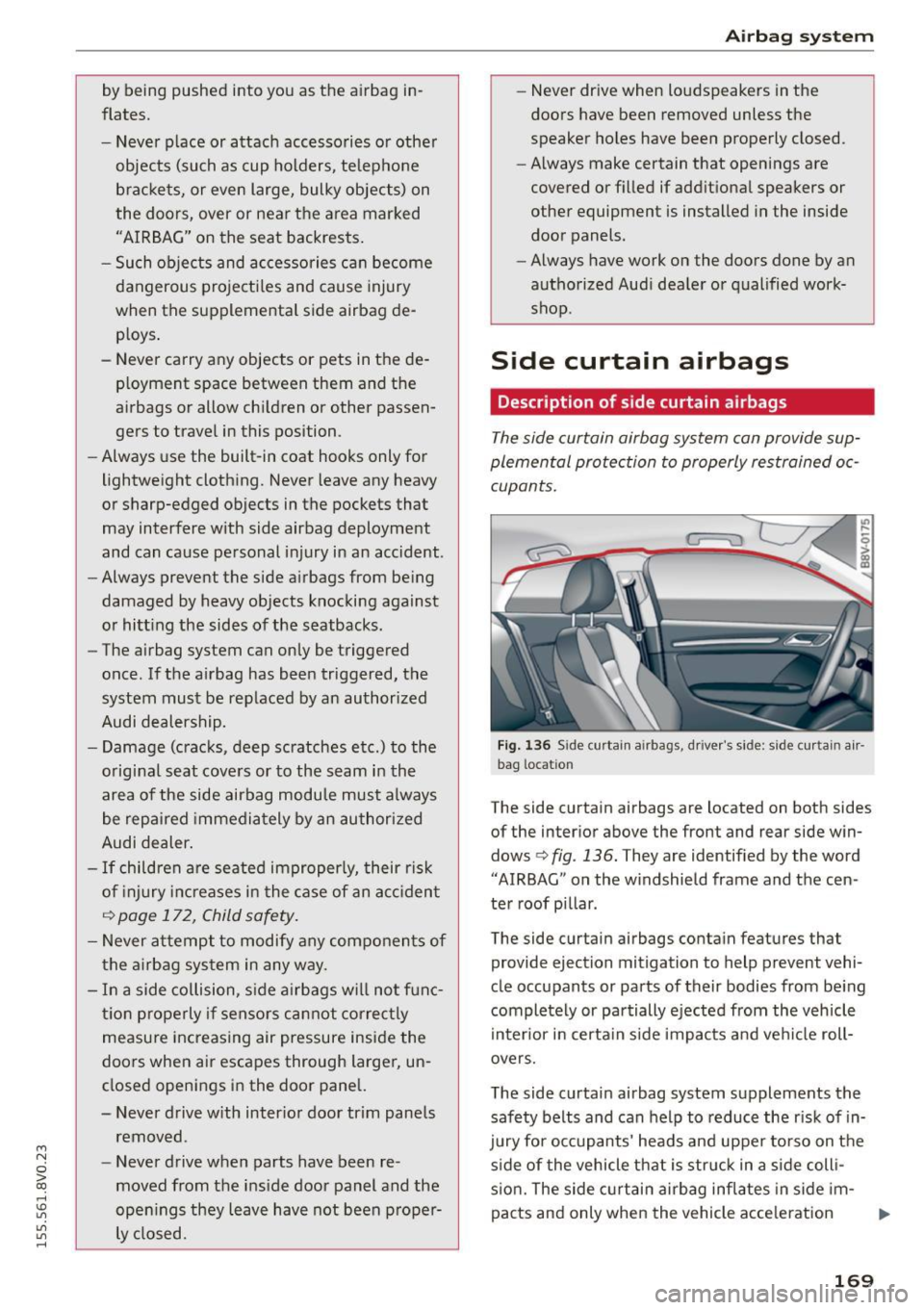
....,
N
0 > co
rl I.O
"'
"'
"'
rl
by being pushed into you as t he a irbag in
flates.
- Never p lace or attach accessories or other
objects (such as cup holders, te lephone
b rac ke ts, or even large, bulky objects) on
the doors, over or near t he area marked
"AIRBAG" on the seat backrests .
- Su ch ob jects and accessories can become
dangerous projecti les and cause injury
when the supplementa l side airbag de
ploys .
- Never carry any objects or pets in the de
p loyment space between them and the
airbags or allow children or other passen
gers to travel in this position.
- Always use the built-in coat hooks only for
lightweight clothing. Never leave any heavy
or sharp-edged objects in the pockets that
may interfere with side airbag deployment
and can cause personal injury in an accident .
- Always prevent the side a irbags from being
damaged by heavy objects knocking against
or hitt ing the sides of the seatbacks.
- The airbag system can only be triggered
once. If the a irbag has been triggered, the
system must be rep laced by an authorized
Audi dealership.
- Damage (cracks, deep scratches etc.) to the
o rigi nal seat cove rs or to the seam in the
area o f the side airbag module must always
be repaired immedia tely by an authorized
Audi dealer .
- If children a re seated improperly, their risk
of inj ury in crea ses in the case of an a ccident
c> page 172, Child safety.
-Never attempt to modify any compo nents of
the a irbag sys tem in any way.
- In a side collision, s ide a irbags will not func
t io n properly if senso rs ca nnot correctly
measu re increasing air pressure inside the
doors when air escapes through larger, un
closed openings in the door pane l.
- Never drive w ith inter ior door trim pane ls
removed.
- Never drive when parts have been re
moved from the ins ide door panel and the
open ings they l eave have not been p rope r
ly closed.
Ai rb ag system
- Never drive when lo udspeakers in the
doors have been removed unless the
speaker holes have been properly closed.
- Always make certain that openings are
covered or filled if additiona l speakers or
other equipment is installed in the inside
door panels.
- Always have work on the doors done by an
authorized Audi dealer or qualified work
shop.
Side curtain airbags
Description of side curtain airbags
The side curtain airbag system can provide sup
plemental protec tion to properly restrained oc
cupants.
Fig . 1 36 Side curtain a irbags , driver 's side: side cu rta in air
bag locat ion
The side curtain airbags are located on both sides
of the inter ior above the front and rear side w in
dows
c> fig . 136. They are identified by the word
"AIRBAG" on the windshield frame and the cen
te r roof pi llar .
The side curtain airbags conta in features that
provide ejection mitigation to help prevent vehi
cle occupants or parts of their bodies from being
completely or partially ejected from the vehicle
i nterior in certa in side impacts and ve hicle roll
overs.
T he side curtain airbag system supplements the
safe ty belts and can help to reduce the r isk of in
jury for occupants' heads and uppe r torso on the
s ide of the vehicle t hat is str uck in a side coll i
s io n. The side curtain airbag inflates in side im -
pacts and only when the vehicle acce leration
Ill--
169
Page 178 of 282
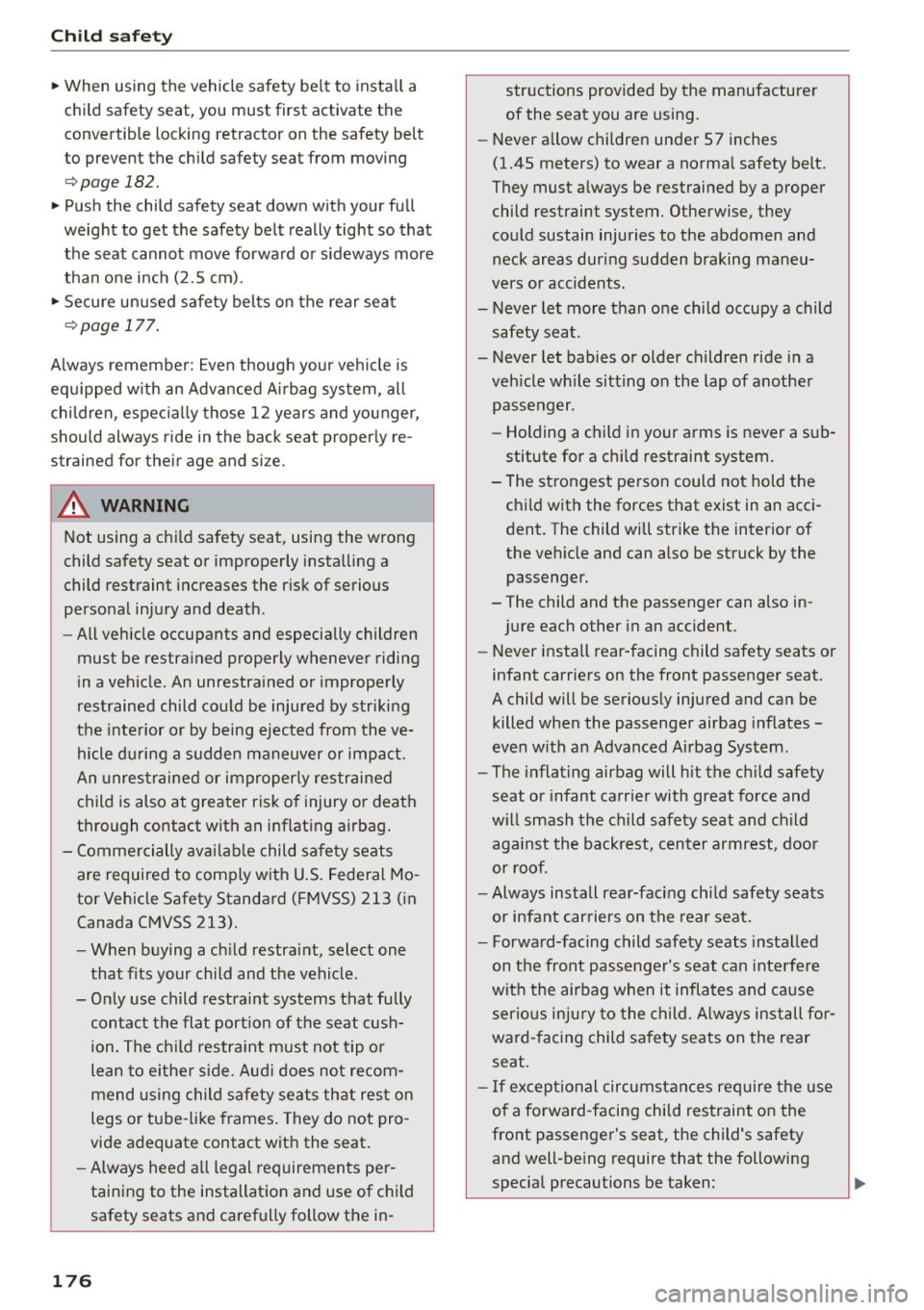
Child safet y
"'When using the vehicle safety be lt to insta ll a
child safety seat, you must first activate the
convertible locking retractor on the safety belt
to prevent the ch ild safety seat from moving
¢ page 182.
"' Push the child safety seat down with your full
weight to get the safety belt really tight so that
the seat cannot move forward or sideways more
than one inch (2.5 cm).
"' Secu re unused safety belts on the rear seat
¢ page 177 .
Always remember: Even thoug h your veh icle is
eq uipped w ith an Advanced Ai rbag system, all
chi ldren, espec ia lly those 12 years and yo unger,
should always ride in the back seat properly re
strained for their age and s ize.
A WARNING
Not using a chi ld safety seat, using the wrong
child safety seat or improperly insta lling a
child restraint increases the r isk of serious
personal injury and death .
- All veh icle occupants and especially children
must be restra ined properly whenever riding
in a vehicle. An unrestrained or improperly
restrained child could be injured by striking
the interior or by being ejected from the ve
hicle du ring a sudden maneuver or impact.
An unrestrained or improperly restrained
child is also at greater risk of injury or death
thro ugh contact with an inflat ing airbag .
- Commercially avai lab le child safety seats
are required to comply with U.S . Fede ral Mo
tor Vehicle Safety Standard ( FMVSS) 213 (in
Canada CMVSS 213).
- When buying a ch ild restraint, select one
that fits your child and the vehicle.
- On ly use child restra int systems that fully
contact the flat port ion of the seat cush
ion. The ch ild restra int must not tip o r
lean to either s ide. Audi does no t recom
mend using child safety seats that res t on
legs o r tube -like frames. They do not pro
vide adequate contact with the seat.
- Always heed all legal requirements pe r
taining to the installation and use of ch ild
safety seats and carefully follow the in-
176
str uctions provided by the manufacturer
of the seat you are using.
- Never allow children under 57 inches
(1.45 meters) to wear a norma l safety belt.
They must always be restrained by a proper
child restraint system. Otherwise, they
could sustain injuries to the abdomen and
neck areas during sudden braking maneu
vers or accidents.
- Never let more than one child occupy a child safety seat.
- Never let babies or o lder children ride in a
veh icle wh ile sitting on the lap of another
passenger .
- Holding a child in your arms is never a sub
stitute for a child restraint system.
- The strongest pe rson could not hold the
child with the forces that exist in an acci
dent. The child will strike the interior of
the veh icle and can also be struck by the
passenger.
- The child and the passenger can also in jure each other in an accident .
- Never install rear-facing child safety seats or
infant carriers on the front passenger seat.
A child will be serious ly injured and can be
killed when the passenger airbag inflates -
even with an Advanced Airbag System .
- The inflating airbag will h it the ch ild safety
seat or infant carr ier with great force and
will smash the child safety seat and child
aga inst the backrest, center armrest, door
or roof.
- Always install rear-facing ch ild safety seats
or infant car riers on the rear sea t.
- Forwa rd-facing child safety seats instal led
on the front passenger's seat can inte rfe re
wit h the airbag when it inflates and cause
serious injury to the child. A lways install fo r
ward-facing child sa fety seats on the rear
seat.
- If except ional circumstances req uire the use
of a fo rward-facing child restraint on the
front passenger's seat, the child's safety
and well-be ing require that the following
special precautions be taken : ..,.
Page 180 of 282
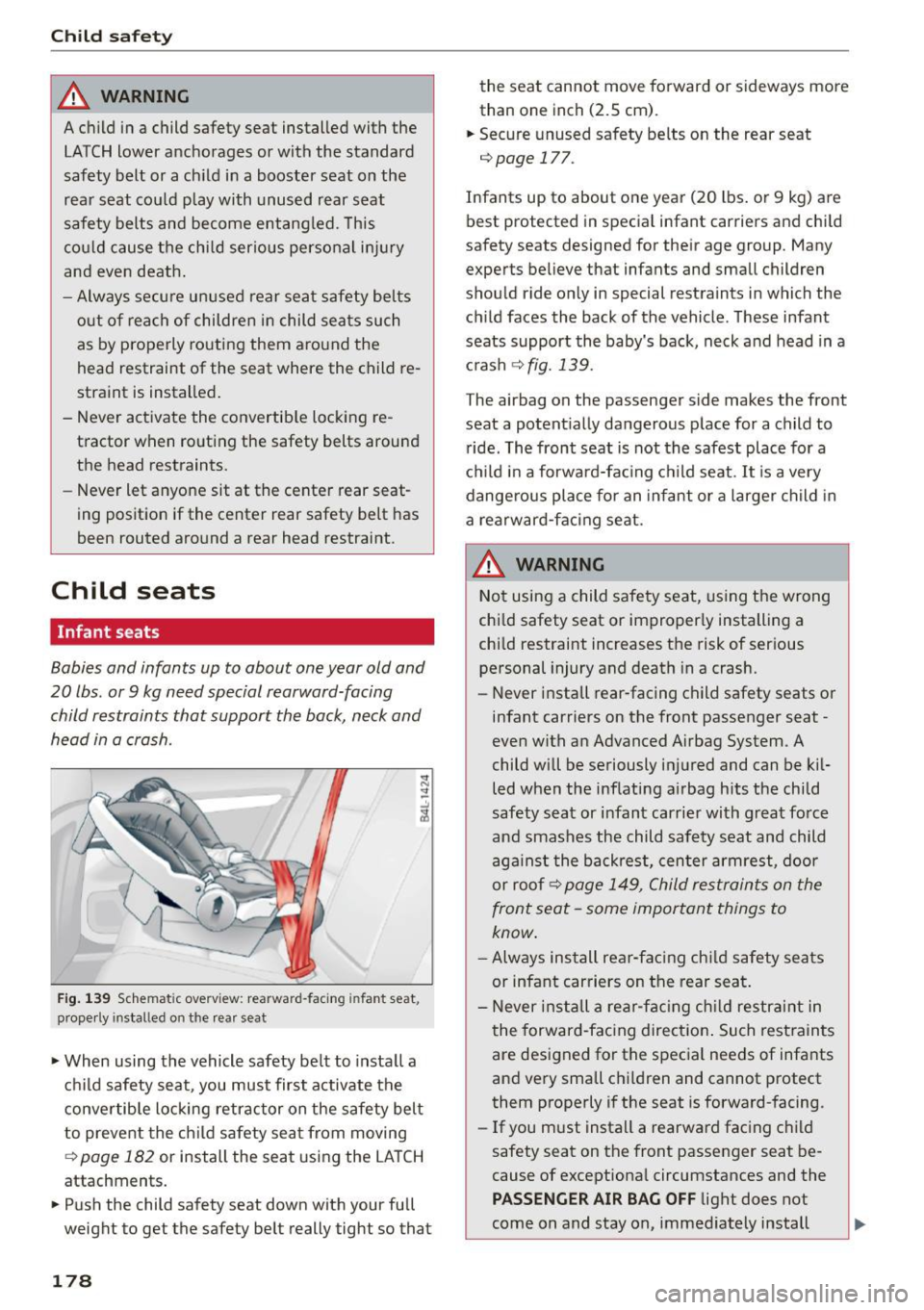
Child safety
_& WARNING
A child in a child safety seat installed with the LATCH lower anchorages or with the standard
safety belt or a child in a booster seat on the
rear seat cou ld play with unused rear seat
safety belts and become entangled. This
could cause the child serious personal injury
and even death.
- Always secure unused rear seat safety belts
out of reach of children in child seats such
as by properly routing them around the
head restraint of the seat where the child re
straint is installed.
- Never activate the convertible locking re tractor when routing the safety belts around
the head restraints.
- Never let anyone sit at the center rear seat
ing position if the center rear safety belt has
been routed around a rear head restraint.
Child seats
Infant seats
Babies and infants up to about one year old and
20 lbs. or 9 kg need special rearward-facing
child restraints that support the back, neck and
head in a crash.
Fig. 139 Schematic overview: rearward-facing infant seat,
properly installed on the rear seat
.. When using the vehicle safety be lt to install a
child safety seat, you must first activate the
convertible locking retractor on the safety belt
to prevent the child safety seat from moving
c::> page 182 or install the seat using the LATCH
attachments.
.. Push the child safety seat down with your full
weight to get the safety belt really tight so that
178
the seat cannot move forward or sideways more
than one inch (2.5 cm).
.. Secure unused safety belts on the rear seat
c::>page 177.
Infants up to about one year (20 lbs. or 9 kg) are
best protected in special infant carriers and child
safety seats designed for their age group. Many
experts believe that infants and small children
should ride only in special restraints in which the
ch ild faces the back of the vehicle. These infant
seats support the baby's back, neck and head in a
crash
c::> fig. 139.
The airbag on the passenger side makes the front
seat a potent ially dangerous place for a child to
ride . The front seat is not the safest place for a
child in a forward-facing ch ild seat.
It is a very
dangerous place for an infant or a Larger child in
a rearward-facing seat.
_& WARNING
Not using a child safety seat, using the wrong
child safety seat or improperly installing a
child restraint increases the risk of serious personal injury and death in a crash.
- Never install rear-facing child safety seats or
infant carriers on the front passenger seat -
even with an Advanced Airbag System. A
child will be seriously injured and can be kil led when the inflating airbag hits the child
safety seat or infant carrier with great force
and smashes the child safety seat and child
against the backrest, center armrest, door
or roof
c::> page 149, Child restraints on the
front seat -some important things to
know .
-Always install rear-facing chi ld safety seats
or infant carriers on the rear seat.
- Never install a rear-fac ing ch ild restraint in
the forward-facing direction. Such restraints
are designed for the special needs of infants
and very small children and cannot protect
them properly if the seat is forward-facing.
- If you must install a rearward facing child
safety seat on the front passenger seat be
cause of exceptional circumstances and the
PASSENGER AIR BAG OFF light does not
come on and stay on, immediately install
~
Page 182 of 282
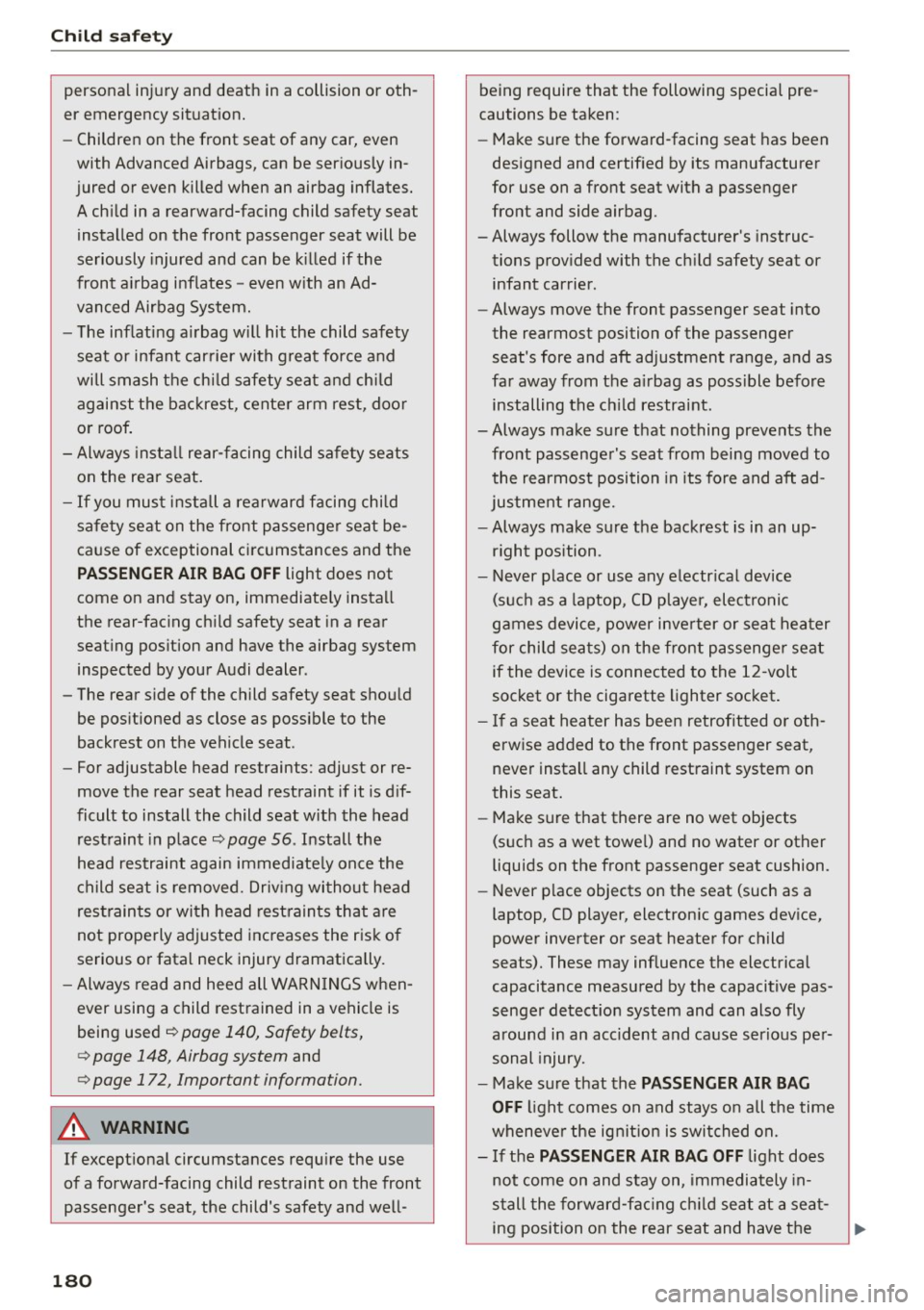
Child safety
personal injury and death in a collision or oth
er emergency situation.
- Children on the front seat of any car, even
with Advanced Airbags, can be seriously in
jured or even killed when an airbag inflates.
A child in a rearward-facing child safety seat
installed on the front passenger seat will be
seriously injured and can be killed if the
front airbag inflates -even with an Ad
vanced Airbag System.
- The inflating airbag will hit the child safety
seat or infant carrier with great force and
will smash the child safety seat and child
against the backrest, center arm rest, door
or roof.
- Always install rear-facing child safety seats
on the rear seat.
- If you must install a rearward facing child
safety seat on the front passenger seat be cause of exceptional circumstances and the
PASSENGER AIR BAG OFF light does not
come on and stay on, immediately install
the rear-facing child safety seat in a rear
seating position and have the airbag system inspected by your Audi dealer .
- The rear side of the child safety seat should
be positioned as close as possible to the
backrest on the vehicle seat .
- For adjustable head restraints: adjust or re
move the rear seat head restraint if it is dif
ficult to install the child seat with the head
restraint in place
Q page 56 . Install the
head restraint again immediately once the
child seat is removed. Driving without head
restraints or with head restraints that are
not properly adjusted increases the risk of
serious or fatal neck injury dramatically.
- Always read and heed all WARNINGS when
ever using a child restrained in a vehicle is
being used
Q page 140, Safety belts,
Q page 148, Airbag system and
Q page 172, Important information.
A WARNING
If exceptional circumstances require the use
of a forward-facing child restraint on the front
passenger's seat, the child's safety and well-
180
being require that the following special pre
cautions be taken :
- Make sure the forward-facing seat has been
designed and certified by its manufacturer
for use on a front seat with a passenger
front and side airbag .
- Always follow the manufacturer's instruc
tions provided with the child safety seat or infant carrier .
- Always move the front passenger seat into
the rearmost position of the passenger
seat's fore and aft adjustment range, and as
far away from the airbag as possible before installing the child restraint .
- Always make sure that nothing prevents the
front passenger's seat from being moved to
the rearmost position in its fore and aft ad
justment range.
- Always make sure the backrest is in an up
right position .
- Never place or use any electrical device
(such as a laptop, CD player, electronic
games device , power inverter or seat heater
for child seats) on the front passenger seat
if the device is connected to the 12-volt
socket or the cigarette lighter socket.
- If a seat heater has been retrofitted or oth
erwise added to the front passenger seat, never install any child restraint system on
this seat.
- Make sure that there are no wet objects
(such as a wet towel) and no water or other
liquids on the front passenger seat cushion.
- Never place objects on the seat (such as a
laptop, CD player, electronic games device,
power inverter or seat heater for child
seats). These may influence the electrical
capacitance measured by the capacitive pas
senger detection system and can also fly
around in an accident and cause serious per
sonal injury.
- Make sure that the
PASSENGER AIR BAG
OFF
light comes on and stays on all the time
whenever the ignition is switched on.
- If the
PASSENGER AIR BAG OFF light does
not come on and stay on, immediately in
stall the forward-facing child seat at a seat-
ing position on the rear seat and have the
~
Page 185 of 282
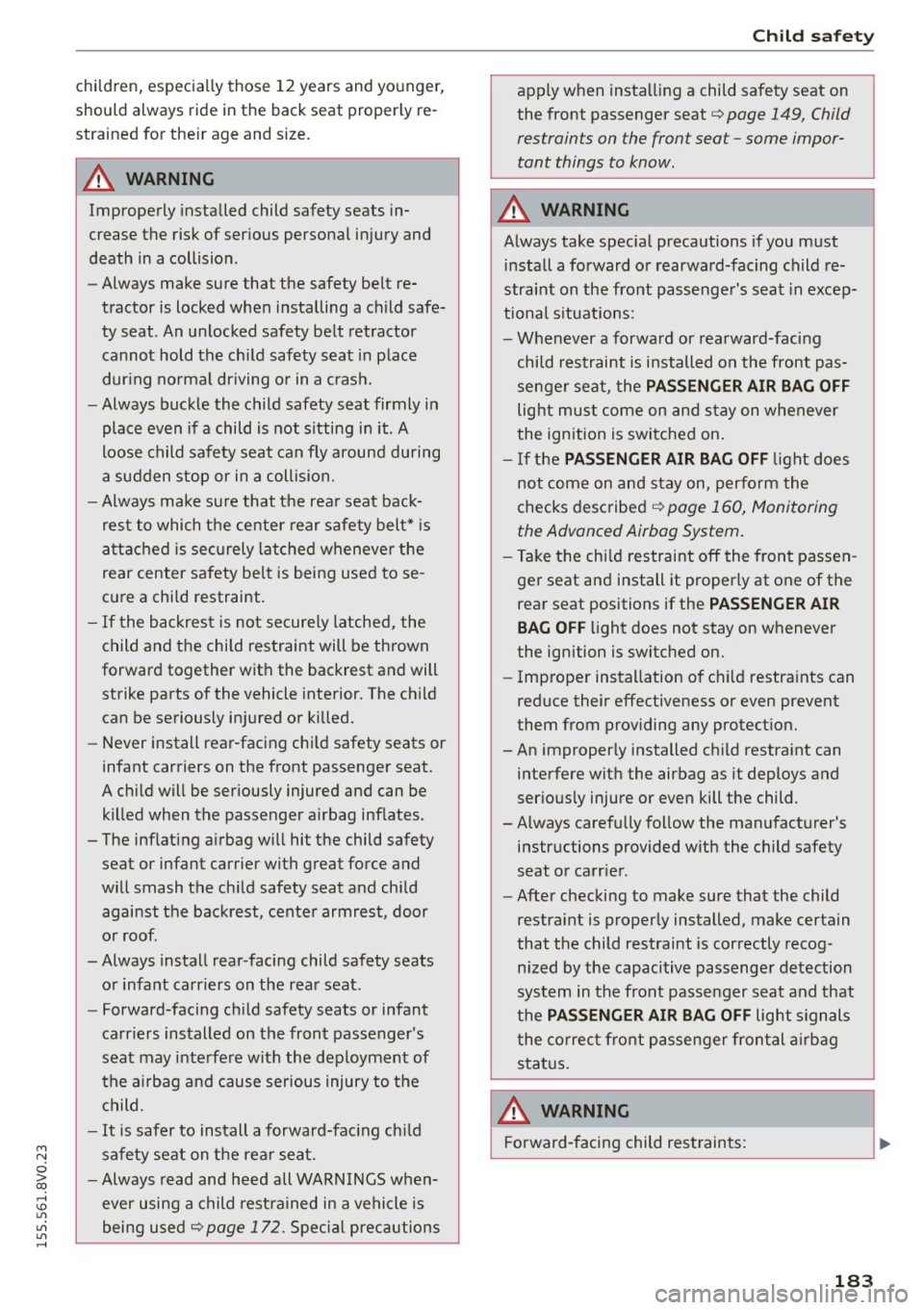
M N
0 > co ,...., \!) ..,.,
..,.,
..,., ,....,
children, especially those 12 years and younger,
should always ride in the back seat properly re
strained for their age and size.
A WARNING
-
Improperly installed child safety seats in
crease the risk of serious personal injury and
death in a collision.
- Always make sure that the safety belt re
tractor is locked when installing a child safe
ty seat. An unlocked safety belt retractor
cannot hold the child safety seat in place
during normal driving or in a crash.
- Always buckle the child safety seat firmly in
place even if a child is not sitting in it . A
loose child safety seat can fly around during
a sudden stop or in a collision.
- Always make sure that the rear seat back
rest to which the center rear safety belt* is
attached is securely latched whenever the
rear center safety belt is being used to se
cure a child restraint.
- If the backrest is not securely latched, the
child and the child restraint will be thrown
forward together with the backrest and will strike parts of the vehicle interior. The child
can be seriously injured or killed.
- Never install rear-facing child safety seats or
infant carriers on the front passenger seat.
A child will be seriously injured and can be killed when the passenger airbag inflates.
- The inflating airbag will hit the child safety seat or infant carrier with great force and
will smash the child safety seat and child
against the backrest, center armrest, door
or roof.
- Always install rear-facing child safety seats or infant carriers on the rear seat.
- Forward-facing child safety seats or infant
carriers installed on the front passenger's
seat may interfere with the deployment of
the airbag and cause serious injury to the child.
- It is safer to install a forward-facing child
safety seat on the rear seat.
- Always read and heed all WARNINGS when
ever using a child restrained in a vehicle is
being used
r:::> page 172 . Special precautions
Child safety
apply when installing a child safety seat on
the front passenger seat
r:::> page 149, Child
restraints on the front seat -some impor
tant things to know .
A WARNING
Always take special precautions if you must
install a forward or rearward-facing child re
straint on the front passenger's seat in excep
tional situations:
- Whenever a forward or rearward-facing
child restraint is installed on the front pas
senger seat, the
PASSENGER AIR BAG OFF
light must come on and stay on whenever
the ignition is switched on.
- If the
PASSENGER AIR BAG OFF light does
not come on and stay on, perform the
checks described
r:::> page 160, Monitoring
the Advanced Airbag System.
- Take the child restraint off the front passen
ger seat and install it properly at one of the
rear seat positions if the
PASSENGER AIR
BAG OFF
light does not stay on whenever
the ignition is switched on.
- Improper installation of child restraints can
reduce their effectiveness or even prevent
them from providing any protection.
-An improperly installed child restraint can interfere with the airbag as it deploys and
seriously injure or even kill the child.
-Always carefully follow the manufacturer's
instructions provided with the child safety
seat or carrier.
- After checking to make sure that the child
restraint is properly installed, make certain
that the child restraint is correctly recog nized by the capacitive passenger detection
system in the front passenger seat and that
the
PASSENGER AIR BAG OFF light signals
the correct front passenger frontal airbag
status.
A WARNING
Forward-facing child restraints:
-
183